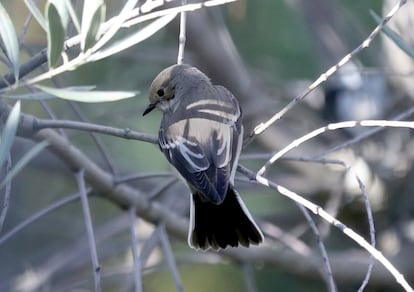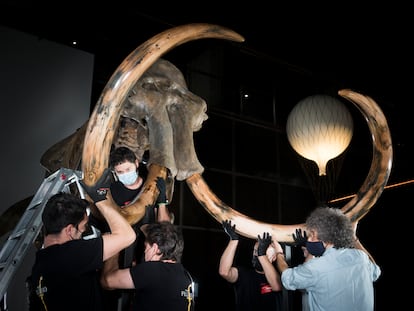The more attractive birds are not the most successful ones at reproduction, study finds
New research on pied flycatchers over a 24-year period shows that sexual ornaments carry costs that can complicate rearing offspring

The development of sexual characteristics, understood as ornaments that highlight their quality, is one of the main weapons that animals have to ensure the transmission of their genes. The most attractive individuals are generally those who also enjoy a better genetic and physical condition. Therefore, one might think that they also achieve greater reproductive success.
However, a study coordinated by researchers at Spain’s National Research Council (CSIC) and published in Journal of Evolutionary Biology, shows how those individuals that have less colored plumage, and therefore are less attractive, could have a reproductive advantage depending on the social context. The reasons that could explain this are the costs involved in having these ornaments that increase attractiveness but can also lead to more disputes and, therefore, less time available to dedicate to the rearing of offspring. This study, which collected data over a 24-year-period, focused on populations of pied flycatchers (Ficedula hypoleuca) in two habitats: a deciduous oak forest and a pine forest in La Hiruela, in Spain’s central Madrid region.
Pied flycatchers are migratory songbirds that are sexually dimorphic in plumage color during the breeding season. The coloration of the dorsal plumage of males varies from brown individuals, similar to females, to completely black individuals. This coloration, as detailed in the research, is hereditary and an indicator of the general quality and attractiveness of the males. The darker individuals establish their breeding territories earlier and produce more complex songs. The total sample size in this research exceeds 2,000 males, according to David Canal, a researcher at the Center for Ecological Research in Hungary and one of the study authors.
However, these ornaments also have environmental and social costs: “When the darker males arrive earlier they are migrating in worse environmental conditions, such as cold, rain or snowfall, and that is energetically demanding,” explains the researcher. Regarding the social costs, these individuals are going to have to compete with other males, defend the territory more intensely, in addition to being seen earlier by predators. “This means that when it comes time for parental care, it will probably be less or of poorer quality, since they will be exhausted by then,” summarizes Canal.
To reach this conclusion, nest boxes (156 in the oak forest and 83 in the pine forest) were observed from the third week of April to the first fortnight of July. Every three days they were checked to determine the occupancy of individual pied flycatchers or other species. Once these boxes were occupied, they were examined daily for laying date, clutch size, hatch date and number of chicks. All the birds of this species were marked with a numbered metal ring and the males, in addition, with a unique combination of colored rings.
This study brings together aspects that, according to Canal, are of great importance. In the first place, it provides information about the environment in a way that creates empathy in society. It also has evolutionary implications, since it includes aspects related to acquiring a mate and reproductive success. “There are animals that are more successful in relation to others and studying the factors that determine this differential success and if this is constant over time, that is, if it changes with environmental conditions or remains constant, is crucial to understanding how they have evolved,” he says. Finally, they have been collecting for many years data from different generations in which they can observe the evolutionary consequences. “This population is very particular because there must be two or three populations like these worldwide,” he concludes.
The duration of the migratory passages of this species has been reduced in the last 40 years in the center and south areas of the Madrid region, according to research included in the Ornithological Yearbook of Madrid, 2015-2017. This study details that, in addition to a decrease of around two weeks in the duration of the passages, departure dates begin significantly earlier. On the other hand, the males arrive on average five days before the females in the prenuptial migration.
Tu suscripción se está usando en otro dispositivo
¿Quieres añadir otro usuario a tu suscripción?
Si continúas leyendo en este dispositivo, no se podrá leer en el otro.
FlechaTu suscripción se está usando en otro dispositivo y solo puedes acceder a EL PAÍS desde un dispositivo a la vez.
Si quieres compartir tu cuenta, cambia tu suscripción a la modalidad Premium, así podrás añadir otro usuario. Cada uno accederá con su propia cuenta de email, lo que os permitirá personalizar vuestra experiencia en EL PAÍS.
¿Tienes una suscripción de empresa? Accede aquí para contratar más cuentas.
En el caso de no saber quién está usando tu cuenta, te recomendamos cambiar tu contraseña aquí.
Si decides continuar compartiendo tu cuenta, este mensaje se mostrará en tu dispositivo y en el de la otra persona que está usando tu cuenta de forma indefinida, afectando a tu experiencia de lectura. Puedes consultar aquí los términos y condiciones de la suscripción digital.
More information
Últimas noticias
Most viewed
- Reinhard Genzel, Nobel laureate in physics: ‘One-minute videos will never give you the truth’
- Oona Chaplin: ‘I told James Cameron that I was living in a treehouse and starting a permaculture project with a friend’
- Pablo Escobar’s hippos: A serious environmental problem, 40 years on
- Why we lost the habit of sleeping in two segments and how that changed our sense of time
- Charles Dubouloz, mountaineering star, retires at 36 with a farewell tour inspired by Walter Bonatti











































